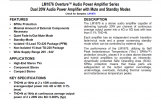- Joined
- Oct 25, 2019
- Messages
- 134
- Likes
- 143
How do you compare the performance of an amplifier section in an active speaker to a separate amplifier + a passive speaker?
For example in the Genelec M040 review, we have these charts:

I think these include distortion from both the built-in amplifier and the rest of the speaker. How would you know whether performance is being held back by the amplifier?
i.e.: how would you be able to compare this to a state-of-the-art (in terms of SINAD) amplifier paired with a passive speaker? In the latter case, you can see the above charts for the passive speaker and you can see the measured SINAD of the amplifier.
And then the bigger question: is the amplifier in an active speaker usually a compromise compared to the best measured amplifier plus passive speakers?
Let's say for example (just making this up), three very highly regarded products here: A Genelec active speaker vs. a Benchmark amplifier + ELAC passive speaker. Would the Benchmark + ELAC always (usually) outperform the Genelec? Is the active speaker necessarily a compromise?
For example in the Genelec M040 review, we have these charts:
I think these include distortion from both the built-in amplifier and the rest of the speaker. How would you know whether performance is being held back by the amplifier?
i.e.: how would you be able to compare this to a state-of-the-art (in terms of SINAD) amplifier paired with a passive speaker? In the latter case, you can see the above charts for the passive speaker and you can see the measured SINAD of the amplifier.
And then the bigger question: is the amplifier in an active speaker usually a compromise compared to the best measured amplifier plus passive speakers?
Let's say for example (just making this up), three very highly regarded products here: A Genelec active speaker vs. a Benchmark amplifier + ELAC passive speaker. Would the Benchmark + ELAC always (usually) outperform the Genelec? Is the active speaker necessarily a compromise?
